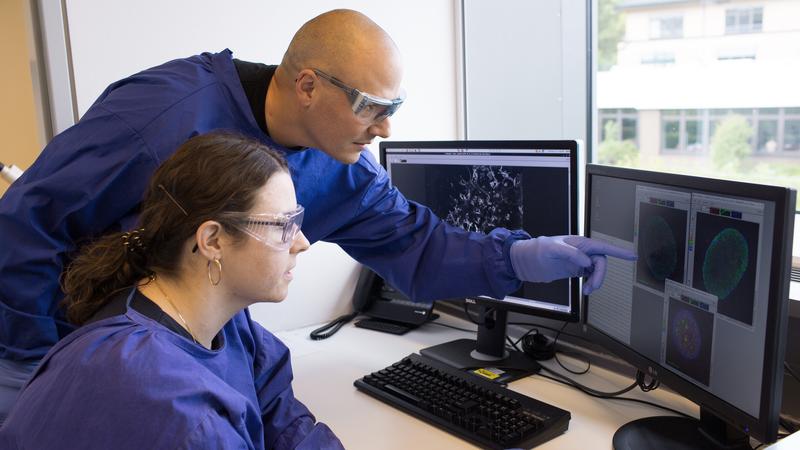Broad-spectrum antiviral compounds discovered
An interdisciplinary research team involving the German Center for Infection Research (DZIF) has identified two antiviral drug candidates effective against a wide range of viruses. The study demonstrates how combining computer-aided modeling with laboratory validation can speed up the development of new antiviral drugs. The researchers used computer simulations to search for specific metabolic processes necessary for viral reproduction but not vital for the cell itself. Using this method, the team identified two active agents that successfully combated various viruses in initial laboratory tests. The study was recently published in the journal Communications Biology.
The COVID-19 pandemic has highlighted the urgent need for antiviral drugs with a broad spectrum of activity—both to treat current infections and to prevent possible new pathogens with pandemic potential. An interdisciplinary research team of bioinformaticians, systems biologists and virologists has now developed a promising method that combines computer-based modeling and experimental testing. This method accelerates the time-consuming identification and development of antiviral agents that could be crucial in the event of future pandemics.
Detecting potential targets for antiviral therapies
Using data from virus-infected tissues, the international research team developed computer models representing the complex metabolism of cells. The team then used these tissue-specific models to simulate the replication of various RNA viruses, which are of particular importance due to their pandemic potential. The modeling revealed metabolic processes that the viruses require for replication but that are not essential for cellular survival.
"Using these models, we have predicted specific metabolic pathways essential for viral replication, which represent potential targets for antiviral therapies," explains Prof. Dr. Andreas Dräger from Martin Luther University Halle-Wittenberg. Until the beginning of this year, Prof. Dräger was a DZIF scientist at the Institute of Bioinformatics and Medical Informatics at the University of Tübingen.
"We then searched existing drug databases for substances that inhibit precisely these metabolic processes," says Alina Renz, the study's first author. Since most viruses have similar basic replication requirements, the international research team from Germany, France, Italy, Greece, and Australia suspected that this strategy could be used to inhibit a wide variety of viruses.
Identifying substances with broad antiviral activity
"We then tested this hypothesis experimentally and found various substances with broad antiviral activity against very different virus families," says Prof. Dr. Michael Schindler, Head of the Molecular Virology Section at the Institute of Medical Virology and Epidemiology of Viral Diseases at University Hospital Tübingen. Infection experiments in cell cultures confirmed that two drug candidates—phenformin and atpenin A5—effectively inhibit viral replication.
"Phenformin interferes with the metabolism of the cell and was therefore previously used as a drug in type 2 diabetes," explains Prof. Dr. Christoph Kaleta from the Institute of Experimental Medicine at Kiel University and the University Hospital Schleswig-Holstein. "Since phenformin is well-characterized for use in humans, our findings could be used to establish supportive therapy against corona or flavivirus infections in the relatively short term."
In animal experiments with SARS-CoV-2-infected hamsters, phenformin significantly reduced the viral load in the respiratory tract. In cell cultures, phenformin also inhibited the multiplication of dengue viruses, for which there is currently no approved treatment.
Extensive clinical studies on the use of phenformin as an antidiabetic agent have already established its safety in humans. Further clinical studies are needed to determine if phenformin has an antiviral effect in humans. In contrast, atpenin A5 is an experimental substance that demonstrates the feasibility of the methodological approach in cell culture. Further studies must be conducted to determine whether variants of the substance can be used in animal models where they are both tolerated and have an antiviral effect.
According to the scientists, the developed methods and identified drug candidates are an important step in the rapid development of potential treatments for future pandemics.
Wissenschaftlicher Ansprechpartner:
Prof. Dr. Andreas Dräger
Martin Luther University Halle-Wittenberg
andreas.draeger@informatik.uni-halle.de
Prof. Dr. Michael Schindler
University Hospital Tübingen
michael.schindler@med.uni-tuebingen.de
Prof. Dr. Christoph Kaleta
Kiel University and University Hospital Schleswig-Holstein
c.kaleta@iem.uni-kiel.de
Originalpublikation:
Renz A. et al, Metabolic modeling elucidates phenformin and atpenin A5 as broad-spectrum antiviral drugs against RNA viruses, Communications Biology, 23 Mai 2025, https://doi.org/10.1038/s42003-025-08148-y
Weitere Informationen:
https://www.dzif.de/en/broad-spectrum-antiviral-compounds-discovered Press release of the German Center for Infection Research (DZIF)
Die semantisch ähnlichsten Pressemitteilungen im idw


